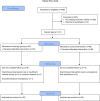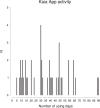App-based multidisciplinary back pain treatment versus combined physiotherapy plus online education: a randomized controlled trial
- PMID: 31304380
- PMCID: PMC6550294
- DOI: 10.1038/s41746-019-0109-x
App-based multidisciplinary back pain treatment versus combined physiotherapy plus online education: a randomized controlled trial
Abstract
Non-specific low back pain (LBP) is one of the leading causes of global disability. Multidisciplinary pain treatment (MPT) programs comprising educational, physical, and psychological interventions have shown positive treatment effects on LBP. Nonetheless, such programs are costly and treatment opportunities are often limited to specialized medical centers. mHealth and other digital interventions may be a promising method to successfully support patient self-management in LBP. To address these issues, we investigated the clinical effects of a multidisciplinary mHealth back pain App (Kaia App) in a randomized controlled trial (registered at German Clinical Trials Register under DRKS00016329). One-hundred one adult patients with non-specific LBP from 6 weeks to 1 year were randomly assigned to an intervention group or a control group. In the intervention group, the Kaia App was provided for 3 months. Control treatment consisted of six individual physiotherapy sessions over 6 weeks and high-quality online education. The primary outcome, pain intensity, was assessed at 12-week follow-up on an 11-point numeric rating scale (NRS). Our per-protocol analysis showed no significant differences between the groups at baseline (Kaia App group: M = 5.10 (SD = 1.07) vs. control group: M = 5.41 (SD = 1.15). At 12-week follow-up the Kaia App group reported significantly lower pain intensity (M = 2.70 (SD = 1.51)) compared to the control group (M = 3.40 (SD = 1.63)). Our results indicate that the Kaia App as a multidisciplinary back pain app is an effective treatment in LBP patients and is superior to physiotherapy in combination with online education.
Keywords: Computational biology and bioinformatics; Pain management.
Conflict of interest statement
Competing interestsThe authors declare no competing interests.
Figures





Similar articles
-
Treatment of Low Back Pain with a Digital Multidisciplinary Pain Treatment App: Short-Term Results.JMIR Rehabil Assist Technol. 2017 Dec 4;4(2):e11. doi: 10.2196/rehab.9032. JMIR Rehabil Assist Technol. 2017. PMID: 29203460 Free PMC article.
-
Using Postmarket Surveillance to Assess Safety-Related Events in a Digital Rehabilitation App (Kaia App): Observational Study.JMIR Hum Factors. 2021 Nov 9;8(4):e25453. doi: 10.2196/25453. JMIR Hum Factors. 2021. PMID: 34751664 Free PMC article.
-
Effectiveness of App-Delivered, Tailored Self-management Support for Adults With Lower Back Pain-Related Disability: A selfBACK Randomized Clinical Trial.JAMA Intern Med. 2021 Oct 1;181(10):1288-1296. doi: 10.1001/jamainternmed.2021.4097. JAMA Intern Med. 2021. PMID: 34338710 Free PMC article. Clinical Trial.
-
The Effect of an App-Based Home Exercise Program on Self-reported Pain Intensity in Unspecific and Degenerative Back Pain: Pragmatic Open-label Randomized Controlled Trial.J Med Internet Res. 2022 Oct 28;24(10):e41899. doi: 10.2196/41899. J Med Internet Res. 2022. PMID: 36215327 Free PMC article. Clinical Trial.
-
Therapeutic ultrasound for chronic low back pain.Cochrane Database Syst Rev. 2020 Jul 5;7(7):CD009169. doi: 10.1002/14651858.CD009169.pub3. Cochrane Database Syst Rev. 2020. PMID: 32623724 Free PMC article.
Cited by
-
Digital self-care in the management of spine musculoskeletal disorders: A systematic review and meta-analysis.Rev Lat Am Enfermagem. 2023 May 12;31:e3908. doi: 10.1590/1518-8345.6423.3908. eCollection 2023. Rev Lat Am Enfermagem. 2023. PMID: 37194893 Free PMC article.
-
Impact of 25 Years of Mobile Health Tools for Pain Management in Patients With Chronic Musculoskeletal Pain: Systematic Review.J Med Internet Res. 2024 Aug 16;26:e59358. doi: 10.2196/59358. J Med Internet Res. 2024. PMID: 39150748 Free PMC article.
-
Digital Therapeutic Care and Decision Support Interventions for People With Low Back Pain: Systematic Review.JMIR Rehabil Assist Technol. 2021 Nov 19;8(4):e26612. doi: 10.2196/26612. JMIR Rehabil Assist Technol. 2021. PMID: 34807837 Free PMC article. Review.
-
Adjunct Digital Interventions Improve Opioid-Based Pain Management: Impact of Virtual Reality and Mobile Applications on Patient-Centered Pharmacy Care.Front Digit Health. 2022 Jun 13;4:884047. doi: 10.3389/fdgth.2022.884047. eCollection 2022. Front Digit Health. 2022. PMID: 35770137 Free PMC article. Review.
-
Effects of an Artificial Intelligence-Assisted Health Program on Workers With Neck/Shoulder Pain/Stiffness and Low Back Pain: Randomized Controlled Trial.JMIR Mhealth Uhealth. 2021 Sep 24;9(9):e27535. doi: 10.2196/27535. JMIR Mhealth Uhealth. 2021. PMID: 34559054 Free PMC article. Clinical Trial.
References
-
- Dalys GBD, Collaborators H. Global, regional, and national disability-adjusted life-years (DALYs) for 333 diseases and injuries and healthy life expectancy (HALE) for 195 countries and territories, 1990-2016: a systematic analysis for the Global Burden of Disease Study 2016. Lancet (Lond., Engl.) 2017;390:1260–1344. doi: 10.1016/S0140-6736(17)32130-X. - DOI - PMC - PubMed
-
- Katz JN. Lumbar disc disorders and low-back pain: socioeconomic factors and consequences. J. bone Jt. Surg. Am. Vol. 2006;88(Suppl 2):21–24. - PubMed
LinkOut - more resources
Full Text Sources
Medical
Miscellaneous

